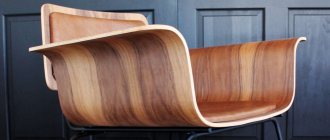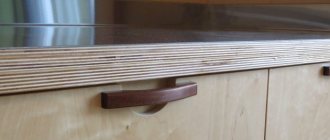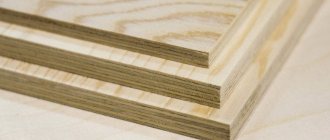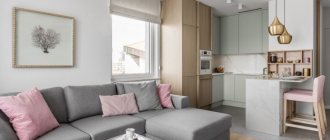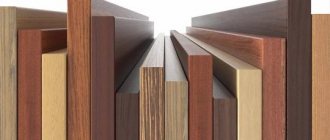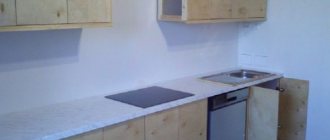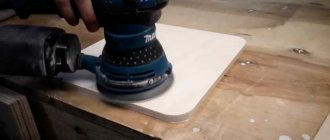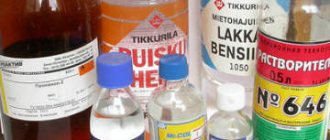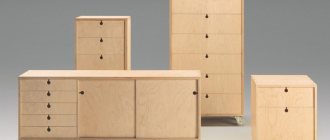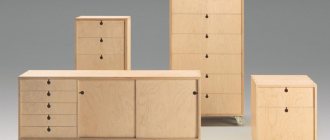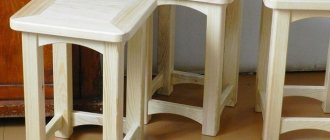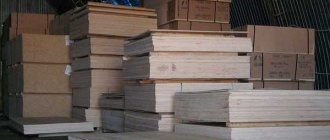The construction and lumber market is constantly changing. Products are modified to improve their technical characteristics. But in the process, manufacturers often push the environmental friendliness of plywood into the background, which can cause serious harm to human health.
This question is especially relevant when choosing building materials for renovating a nursery. Here, safety comes first, since a young and fragile body is very vulnerable, and therefore will not be able to withstand toxins for long.
There are four basic safety principles:
- chemical – a parameter according to which the materials used in residential premises should not emit volatile toxins into the surrounding atmosphere or their concentration should not exceed permissible standards;
- physical – compliance with sound and heat insulation standards;
- firefighter – compliance with flammability standards;
- biological – treatment of materials with safe antiseptic agents that prevent the development of mold or mildew.
Below you can study a short instruction, which contains a description of the main types of plywood, as well as their characteristics. This information will allow you to choose the most rational balance between quality and environmental friendliness.
Eco-friendly plywood
Environmental friendliness is one of the key requirements that modern consumers place on building materials. This is a guarantee of good health for all residents, a guarantee of safety and absence of harm to health. Unfortunately, when producing blanks, environmental friendliness is not in the first place, which is why buyers often suffer. This is especially unpleasant when it comes to using plywood in a children's room, where any harmful effects can affect a fragile little body.
The safety principles of building materials are classified as follows:
- Chemical. According to it, materials that are allowed to be used indoors must not emit toxins.
- Firefighter: the workpieces must be safe from this point of view.
- Biological. It involves treating workpieces with safe antiseptic solutions that prevent the spread of mold and mildew.
- Physical - implies compliance of all elements with heat and sound insulation standards.
DIY furniture.
Materials: chipboard, fiberboard, MDF. What it is? What are the differences? A short review of materials.
Chipboard (chipboard)
Oh, who among us doesn’t know chipboard! Who hasn’t said in disappointment: “Well, this is deespe...” But let’s get to the point. Chipboard is made from sawdust and shavings impregnated with a binder, namely formaldehyde resins. This is the most common material for cabinet furniture, interior design, construction (roofs, partitions, etc.).
Pros: water resistance, strength, ease of processing. Chipboard “holds” nails and screws holding the structure together well. Another advantage of chipboard is its low price. That is why chipboard is the most widely used material for economy class furniture; Most office furniture is made from chipboard.
For kitchens and baths, a special type of chipboard is used - with increased moisture resistance.
Cons: the presence of those very formaldehyde resins that hold wood particles together. The fact is that chipboard releases a certain amount of formaldehyde into the air - not the most healthy product, it should be noted. But it's not all that scary. There are two types of chipboard: E1 and E2. E1 is more environmentally friendly; its formaldehyde emission rate is noticeably lower. But E2 is prohibited from being used in the production of children's furniture: draw your own conclusions. The most environmentally friendly are chipboards made in Austria and Germany.
Chipboard is a very hard material that does not allow fine processing (deep milling, all kinds of shaped parts).
Classification and designations of chipboard.
Particleboards are made from different types of wood raw materials and non-wood particles using different types of binders, in different ways and for different purposes.
Let's look at the classification and types of slabs using their markings as an example: P-A, 1, M, Sh, E1, 3500x1750x16, GOST 10632-89
.
The standards existing in Russia distinguish two grades of chipboard: P-A and P-B. These brands differ in their physical and mechanical characteristics. Grade P-A is of higher quality and has better bending and tensile strength and lower percentages of swelling, warping and surface roughness than grade P-B.
There are slabs of 1st grade, 2nd grade, as well as non-grade slabs, which are usually used for construction purposes.
The main differences between grades 1 and 2:
- No protrusions or depressions, resin or paraffin stains are allowed on the first grade slab;
- On a first-grade slab, chipping of edges and chipping of corners is not allowed (with the exception of single chips (chipping) up to 3 mm and extending along the edge up to 15 mm); on a second-grade slab, chipping of the edges is allowed within the limits of deviations along the length (width) of the slab;
- there may be grinding defects on the surface of the second grade slab (no more than 10% of the area);
- On the surface of a slab of the second grade, inclusions of bark and large fractions of chips may be present to a greater extent compared to the first grade.
The third position (in our example: M) is the type of outer layer of chipboard.
Based on the type of outer layer, a distinction is made between slabs with a fine-textured surface (M), a regular surface, and slabs with outer layers of coarse chips. The latter are used only for construction purposes and for cladding with natural veneer.
The fourth position (in our example: Ш) is surface treatment of chipboard.
The slabs can be polished (Ш) or unpolished.
The fifth position (in our example: E1) is the formaldehyde emission class in chipboard.
The emission class shows the permissible content of free formaldehyde in 100 grams of a completely dry board according to GOST 10632-89. There are two emission classes: E1 (up to 10 mg), E2 (10-30 mg). Manufacturing boards with a high content of formaldehyde is unacceptable.
The sixth position (in our example: 3500x1750x16) is the dimensions of the chipboard in mm.
The seventh position (in our example: GOST 10632-89) is the GOST number on the chipboard.
For cladding with paper-resin films (lamination and laminating), sanded chipboard of grade P-A, first (rarely second) grade with a fine-textured surface and formaldehyde emission E-1 (worse E-2) is used.
For the production of children's furniture, only class E-1 board should be used.
Continuing the topic of chipboard classification, mention should be made of the following additional properties that can be imparted to the boards:
Water resistance.
The slabs come in standard and increased (letter “B” in the marking) water resistance. In the vast majority of cases, slabs with ordinary water resistance are used. It is advisable to use slabs of increased water resistance for the manufacture of countertops for kitchens, furniture for bathrooms, as well as for special construction purposes.
When making waterproof chipboard, before pressing, a special paraffin emulsion or molten paraffin is introduced into the chip mass. An indicator of water resistance is swelling in thickness (over 24 hours, upper limit):
- regular chipboard, grade P-A - 22%,
- regular chipboard, grade P-B - 33%,
- waterproof chipboard - no more than 15%.
Fire resistance.
To make chipboard fire-resistant, special substances are introduced into its composition - fire retardants. Currently, there is no specialized production of fire-resistant boards in Russia.
Laminated chipboard
This is a chipboard lined with a film based on thermosetting polymers (paper-resin films). How is the film made? At first it looks like regular paper. The most famous manufacturer of such paper is Interprint; There are a huge number of shades and textures of paper, so you can’t complain about the monotonous appearance of laminated chipboard.
After impregnation with melamine resin, the paper becomes hard and brittle; then, using pressing, the film is “tightly” connected to the surface of the chipboard.
Pros: variety of colors and textures, imitation of the texture of natural wood, resistance to all kinds of mechanical damage, resistance to thermal effects (in other words, to hot coffee pots and frying pans).
Disadvantage: the same as with chipboard: the impossibility of fine processing.
Can plywood be environmentally friendly?
As we have already noted, plywood itself is an environmentally friendly material, because it is made of natural wood veneer. But the compositions that are responsible for gluing the sheets can be different - from completely harmless to chemically hazardous.
The following components violate the environmental friendliness of plywood:
- Phenol-formaldehyde glue is a toxic adhesive that makes building materials more durable. This substance is based on formaldehyde, which, if it comes into contact with the skin or mucous membranes, causes irritation, and if the substance gets inside the body, it can affect the nervous system. The maximum concentration of formaldehyde in the air is 0.5 mg per cubic meter. Lethal dose – 50-70 grams. Of course, no plywood contains such a volume of toxic substances, but as a precaution, materials with a relatively high resin content are not recommended for use in areas where people or animals spend a lot of time.
- Melamine glue is less toxic than the previous one, but also harmful. Used to make the material moisture resistant.
- Urea and albumin casein glues. The safest connections that increase the performance characteristics of plywood, but do not make it dangerous for households.
- Bakelite varnish. This product also increases the strength and moisture resistance of the material by impregnating it and gluing it together. Also toxic.
Depending on how the sheets are glued together, plywood is divided into the following grades:
- FBA is the most environmentally friendly material, the production of which uses the albumin-casin composition. This product does not cause allergies and does not harm the health of humans and animals. You have to pay for naturalness: such plywood cannot boast of either high strength or resistance to moisture, so the scope of application of the material is extremely limited. As a rule, FBA is used indoors, for example, to decorate a children's room or storage room.
- – plywood impregnated with urea resins. They increase the strength of the material, and, as a result, expand the possibilities of its use, but reduce environmental friendliness. However, FC plywood is not considered dangerous.
- FSF. This material is in great demand, because it can be used both in construction and for exterior decoration of buildings. This plywood is moisture resistant, strong and durable. These properties are given to the material by a special impregnation, which includes phenol-formaldehyde glue. This composition releases toxic substances harmful to human health. Therefore, using FSF plywood indoors is risky.
- FOF. This plywood is covered with a special laminating layer, the environmental friendliness of which leaves much to be desired. Formaldehyde compounds are also used in the production of this coating, so FOF is more suitable for outdoor use.
- FB – bakelite plywood – is the least environmentally friendly material of all existing brands. The compounds connecting the sheets contain formaldehyde, methanol and toxic phenol, which are extremely dangerous to human health and pets. It is strictly forbidden to use it indoors. But in strength it surpasses many other building materials, so it is often used for external work.
Thus, only one brand of plywood can be called environmentally friendly - FBA. It is absolutely natural and safe even for children.
There is another classification of plywood - according to the level of formaldehyde content:
- E0 – no more than 6 mg per 100 g;
- E1 – from 7 to 9 mg per 100 g;
- E2 – 10-20 mg per 100 g;
- E3 – 30-60 mg per 100 g.
Obviously, the lower the concentration of toxic substances, the safer and more environmentally friendly the plywood. Most materials on the domestic market are marked E2.
Health Hazard
It is a mistake to classify plywood as a product that is completely environmentally friendly, because even natural wood does not guarantee complete safety. This is explained by the fact that the resins contained in the structure may have some negative effects.
The use of glue to join veneer affects the toxicity of the material; the most harmful are the fumes of phenol and formaldehyde. These components are included in most binder solutions for plywood; bakelite varnish also contains a certain amount of substances. Therefore, all materials can emit fumes that adversely affect human health.
In addition to the certificate of conformity, which is issued for each type of plywood, for the use of the material in enclosed residential premises, it is desirable that the accompanying documents also include an expert opinion from the SES
Symptoms of toxic effects:
- Headache. Problems begin with the appearance of heaviness and fogginess. Subsequently, if the influence is constant, migraines develop. Symptoms worsen when staying in a room lined with hazardous material; in the fresh air, the pain syndrome decreases.
- Sore throat. Gradually, a minor problem develops into a serious, painful cough, which can lead to chronic respiratory disease.
- Nausea, vomiting. These symptoms indicate severe poisoning.
- Fatigue. Harmful substances worsen the general condition of the body: appetite decreases, lethargy, apathy and drowsiness appear.
Continued exposure to one or more symptoms can lead to significant problems requiring medical attention. But such serious consequences are possible only when purchasing very low-quality products. Most often, such materials are produced by unknown companies or imported from Asian countries.
On a note! The presence of toxic substances in plywood products in permitted quantities is neutralized by finishing: painting, gluing or covering surfaces can almost completely eliminate harmful evaporation.
It is believed that laminating, painting or covering sheets with some kind of film material blocks harmful fumes from plywood
Application
Plywood has strength, durability, lightness and rigidity. It also has increased resistance to deformation, bending and splitting. In almost every hardware store it can be purchased at a fairly affordable price. Plywood, given its environmental friendliness, is used not only in traditional construction projects, but also in shipbuilding, creating aquariums and tanks.
The use of this material to create furniture and partitions is widespread. Its high strength allows it to be used in combination with ordinary wood or other framing materials. This versatility and environmental friendliness of interior plywood has led to it becoming a favorite among designers and interior decorators.
When purchasing this material, please note that there are different grades. The usual grading system uses numbers from 1 to 4, as well as the letter E - an elite grade that does not allow any defects. Grade 1 - best quality, virtually no defects, very well polished. Grade 4 is extremely low quality, usually containing the maximum permissible number of defects. Double marking. The first number or letter refers to the outside, and the second to the inside. Each variety has its own area of application.
Advantages of plywood:
- Quite resistant to unfavorable climatic conditions.
- Less likely to warp or crack than solid wood.
- It has good appearance and high strength at a lower price.
Cons of plywood:
- The veneer can chip, exposing the less expensive wood underneath.
- The damage is difficult to repair.
- Some types of plywood use glue and formaldehyde.
Production
In the plywood manufacturing process, individual layers of veneer are first obtained by rotary cutting of wood. To do this, the logs are rotated around the longitudinal axis, and the cutter cleans it (the thickness of each layer is usually less than 2.5 mm). Next, the glue is applied to the layers using a special machine. It helps in achieving uniform distribution of the glue. In this case, the layers are superimposed on each other and pressed tightly using a hot pressing machine.
The high temperature and pressure created by this technique ensures strong adhesion of the layers. Their number in each sheet of plywood can vary from 3 to 13. The thickness of the sheets from different manufacturers ranges from 3 mm to 30 mm. Standard sheet sizes are 1220 by 2440 mm. There are other sizes that are more convenient to use. It all depends on the manufacturer. The user can cut or sand these sheets according to the required specifications. There are several main types of glue used for manufacturing. The type of plywood, composition, and environmental friendliness should be studied before purchasing.
